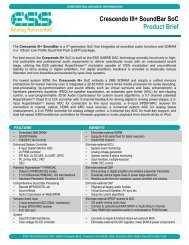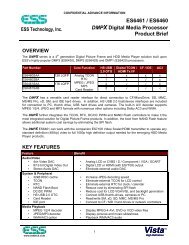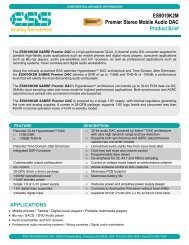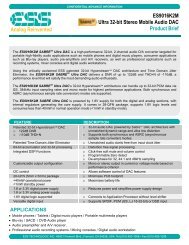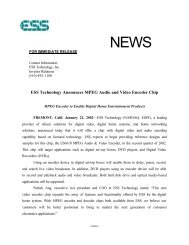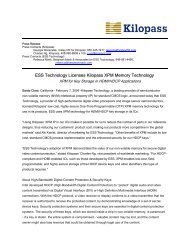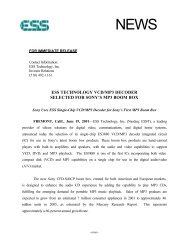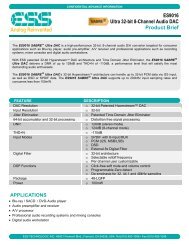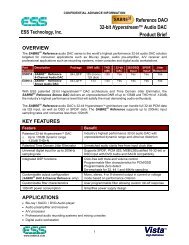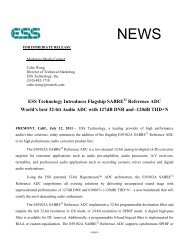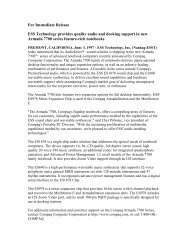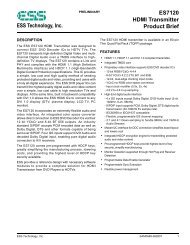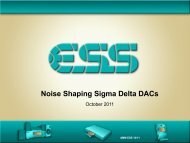Maximizing DAC Performance for Every Budget - ESS Technology, Inc.
Maximizing DAC Performance for Every Budget - ESS Technology, Inc.
Maximizing DAC Performance for Every Budget - ESS Technology, Inc.
You also want an ePaper? Increase the reach of your titles
YUMPU automatically turns print PDFs into web optimized ePapers that Google loves.
Master Clock<br />
As detailed in the datasheet, the MCLK must be at least 386*Fs <strong>for</strong> SPDIF inputs and 192*Fs <strong>for</strong><br />
Serial/DSD inputs. For optimum jitter tolerance the MCLK should be at least 10% higher than this<br />
theoretical MCLK minimum, this ensures audio clarity free from input clock jitter.<br />
If operating with a synchronous MCLK, it is recommended to use an inverted MCLK. The inverted<br />
synchronous MCLK ensures that the Sabre noise is as low as possible.<br />
Printed Circuit Board Design<br />
Proper PCB layout <strong>for</strong> the Sabre <strong>DAC</strong> is vital to the circuit’s per<strong>for</strong>mance. Time spent achieving optimum<br />
component placement provides a good foundation to make the routing task provide the best per<strong>for</strong>ming<br />
circuit within the real estate provided. <strong>Every</strong> design will have different requirements, PCB stackup, via<br />
size, PCB size, component sizes, etc. <strong>ESS</strong> has experimented with <strong>DAC</strong> evaluation PCBs ground planes to<br />
determine any benefit of split plane grounds <strong>for</strong> analog and digital ground. It is our finding and<br />
recommendation to use only one ground plane <strong>for</strong> both digital and analog grounds as it simplifies layout<br />
and provides no per<strong>for</strong>mance degradation. The most important <strong>for</strong> <strong>DAC</strong> per<strong>for</strong>mance is the ground plane,<br />
it should be as solid as possible with as few traces routed through the ground plane as possible. Any traces<br />
that are routed through the ground plane and block the “line of sight” from the <strong>DAC</strong> output to the opamp<br />
output stage significantly degrades the output THD. <strong>ESS</strong> recommends using the evaluation board designs<br />
as a guide <strong>for</strong> your own PCB layout. Critical PCB layout items:<br />
1.) Make the ground plane as solid as possible. Try to keep all ground connections as short as possible.<br />
<strong>Every</strong> ground connection should have its own via, do not share vias if possible.<br />
2.) Keep opamp feedback paths as close as possible to the opamp.<br />
3.) Ensure every opamp and <strong>DAC</strong> has decoupling capacitance on its power supply right next to the power<br />
supply pins.<br />
4.) The audio path between the <strong>DAC</strong> and the opamp stage should be kept as short and clean as possible.<br />
5.) The audio path after the opamps is not as critical.<br />
6.) Try to keep the digital circuitry away from the analog circuitry.<br />
Figure 5 shows the Sabre <strong>DAC</strong> Reference 64LQFP Evaluation Board. Each section of the circuit board is<br />
described in detail below.<br />
Figure 5: Sabre <strong>DAC</strong> Reference 64LQFP Evaluation Board



